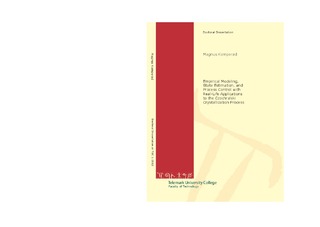| dc.description.abstract | This PhD thesis presents research work within the field of systems and control engineering, with emphasis on applications to real-life processes, the Czochralski (CZ) crystallization process in particular. During the PhD study, two journal articles and five conference papers have been published. All seven publications are based on logged data from real-life processes or include examples based on such data. For four of the publications, logged process data are essential. The seven publications are referred to as Paper A through Paper G. The publications focus on data preprocessing, empirical modeling, process control, and state estimation for the purpose of noise filtering. The Czochralski (CZ) crystallization process is a batch process that converts multicrystalline materials into monocrystalline materials, i.e. materials that have homogeneous crystal structures. Among the most important applications of the CZ process is production of monocrystalline silicon. This is the only application of the CZ process that has been considered during this PhD study. Monocrystalline silicon is used in solar cell wafers and in computers and electronics. Solar cells based on monocrystalline silicon have higher efficiency than those based on multicrystalline silicon. During the CZ batch process, multicrystalline silicon is melted in a crucible. The silicon is then solidified on a monocrystalline seed crystal, thereby growing a crystal. The grown crystal is monocrystalline and is referred to as an ingot. There are several challenges associated with modeling and control of the CZ process: (i) The process dynamics is challenging to model using mechanistic (first principle) modeling. (ii) The process has multivariable character. (iii) The process is timevariant due to its batch nature. (iv) There are several difficulties regarding sensor technologies. In particular the ingot diameter is difficult to measure online. The candidate?? literature search indicates that most published research works considering modeling and control of the CZ process are simulation studies, which are not validated against real-life processes. Only one publication was found that documents that a suggested control strategy works on real-life CZ processes. During the PhD study, the candidate had access to a real-life CZ process at SINTEF Materials and Chemistry in Trondheim, Norway. As published research results that are validated on real-life CZ processes seem to be rather sparse, the candidate focused his research on experiments at this plant. Unfortunately, issues regarding sensor technologies forced the candidate to focus on other parts of the CZ process than initially planned. However, these issues have also given useful experiences and provided ideas for further research. The work of this PhD study has focused on the heating element power and the temperature of the molten silicon. The ingot diameter has not been considered, partly because of unreliable diameter sensor, partly because the diameter depends on the silicon temperature. Hence, it is reasonable not to consider the ingot diameter until the heating element power and the silicon temperature are properly measured, modeled, and controlled. Logged process data from the SINTEF CZ plant are used extensively during this PhD study. Paper D and Paper E consider empirical modeling of the heating element power, Paper F suggests a cascade control strategy for improving temperature control of the molten silicon, and Paper G presents state estimation for the purpose of measurement noise filtering. Also, logged process data from the SINTEF CZ plant are used as an example in Paper C. Paper A and Paper B include work on logged process data from the copper refining process at Xstrata Nikkelverk in Kristiansand, Norway. These data were made available from the process by Dr. Tor Anders Hauge. Paper A presents work on data preprocessing, using the Xstrata data as real-life examples. Paper B considers system identification and compares two system identification algorithms using process data from Xstrata. System identification is the science of developing dynamic, empirical models based on process inputs and the corresponding process outputs. | |
